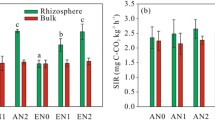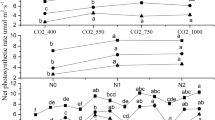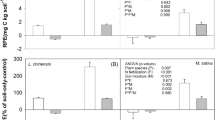Abstract
The exotic crucifer Lepidium latifolium L. (perennial pepperweed) is invading wetland and riparian habitats throughout the western United States. Based on previous field studies, our working hypothesis proposed that L. latifolium elevates soil nutrient acquisition ability in response to CO2 enrichment. Replicates of L. latifolium were grown in a high fertility and low fertility soil (along with unplanted controls) in a glasshouse at ambient and elevated CO2 concentrations (360 and 699 μmol mol−1, respectively). Plants were harvested after 81 days and numerous plant and soil attributes measured. Above-ground plant mass was influenced by a significant CO2 treatment × soil interaction (P<0.001) with CO2 enrichment inducing a greater proportional increase in mass for the low fertility soil. Root concentrations of citrate, malate, and ortho-phosphate and enzyme activities of amidase and asparaginase did not differ between the CO2 treatments across soils. Above-ground tissue concentrations of N, S, P, Mg, K, Fe, and Zn consistently decreased for both soils with CO2 enrichment, corresponding with higher biomass per unit nutrient. Plants grown in the low fertility soil had higher concentrations of N, S, P, Ca, and Mg in above-ground tissue than plants grown in the high fertility soil. Carbon dioxide enrichment decreased tissue N:S ratios by > 20% and increased, though not significant, tissue C:N ratio by 38% in high fertility soil and by 51% in low fertility soil. For most soil attributes measured, there was a main effect or interaction with soil fertility level. Soil attributes differed between soil fertility levels and, with the exception of SO4 2−, were not influenced by the presence of L. latifolium. Soil attributes increased by CO2 enrichment included acetate extractable Mg2+ (high fertility soil only), net 30 day N mineralization potential (unplanted control soils only), available N (high fertility soil), bicarbonate extractable P, soil-solution SO4 2− (L. latifolium planted pots only), and soil-solution Mg2+ (high fertility control soil only). Collectively, these data tangentially support our working hypothesis that CO2 enrichment increases nutrient availability. That availability of some nutrients increases without plant growth (control soils), however, suggests an interaction of elevated CO2 with soil microflora.
Similar content being viewed by others
References
Barrett D J, Richardson A E and Gifford R M 1998 Elevated atmospheric CO2 concentrations increase wheat root phosphatase activity when growth is limited by phosphorus. Aust. J. Plant Physiol. 25, 87-93.
Barrett D J and Gifford R M 1999 Increased C-gain by an endemic Australian pasture grass at elevated atmospheric CO2 concentration when supplied with non-labile inorganic phosphorus. Aust. J. Plant Physiol. 26, 443-451.
Baxter R, Gantley M, Ashenden T W, and Farrar J F 1994 Effects of elevated carbon dioxide on three grass species from montane pasture II. Nutrient uptake, allocation and efficiency of use. J. Exp. Bot. 45, 1267-1278.
Bazin A, Goverde M, Erhardt A, and Shykoff J A 2002 Influence of atmospheric carbon dioxide enrichment on induced response and growth compensation after herbivore damage in Lotus corniculatus. Ecol. Entomol. 27, 271-278.
Bazzaz F A and Garbutt K 1988 The response of annuals in competitive neighborhoods: Effect of elevated CO2. Ecol. 69, 937-946.
Blank R R, Qualls R G, and Young J A 2002 Lepidium latifolium: Plant nutrient competition-soil interactions. Biol. Fert. Soils 35, 458-464.
Blank R R 2002 Amidohydrolase activity, soil N status, and the invasive crucifer Lepidium latifolium. Plant Soil 239, 155-163.
Blank R R and Young J A 2002 Influence of the exotic invasive crucifer, Lepidium latifolium, on soil properties and elemental cycling. Soil Sci. 167, 821-829.
Bundy L G and Meisinger J J 1994 Nitrogen availability indices. InMethods of Soil Analysis, Part 2 Microbiological and Biochemical Properties. Ed. RW Weaver et al. pp. 951-984. Soil Sci. Soc. Amer. Inc., Madison, WI.
Campbell C D and Sage R F 2002 Interactions between atmospheric CO2 concentration and phosphorus nutrition on the formation of proteoid roots in white lupin (Lupinus albusL.) Plant Cell Environ. 25, 1051-1059.
Davey P A, Parson A J, Atkinson L, Wadge K and Long S P 1999 Does photosynthetic acclimation to elevated CO2 increase photosynthetic nitrogen-use efficiency? A study of three native UK grassland species in open-top chambers. Funct. Ecol. 13, 21-28.
Derner J D, Johnson H B, Kimball B A, Pinter Jr. P J, Polley H W, Tischler C R, Boutton TW, LaMorte R L, Wall GW, Adam N R, Leavitt S W, Ottman M J, Matthias A D and Brooks T J 2002 Above-and belowground responses of C3-C4 species mixtures to elevated CO2 and soil water availability. Global Change Biol. 9, 452-460.
Dukes J S and Mooney H A 1999 Does global change increase the success of biological invaders? Trends Ecol. Evol. 14, 135-139.
Dukes J S 2002 Comparison of the effect of elevated CO2 on an invasive species (Centaurea solstitialis) in monoculture and community settings. Plant Ecol. 225, 225-234.
Fangmeier A, Grüters U, Högy P, Vermehren B and Jäger H J 1997 Effect of elevated CO2, nitrogen supply and tropospheric ozone on spring wheat-II. Nutrients (N, P, K, S, Ca, Mg, Fe, Mn, Zn). Environ. Poll. 96, 43-59.
Hagedorn F, Landolt W, Tarjan D, Egli P, and Bucher J B 2002 Elevated CO2 influences nutrient availability in young beech-spruce communities on two soil types. Oecologia 132, 109-117.
Hart S C, Stark J M, Davidson E A and Firestone M K 1994 Nitrogen mineralization, immobilization, and nitrification. InMethods of Soil analysis part 2 Microbiological and Biochemical Properties. Ed. R W Weaver et al. pp. 985-1018. Soil Sci. Soc. Amer. Inc., Madison, WI.
Hoffland, E, Van den Boogaard, R, Nelemans J, and Findenegg G 1992 Biosynthesis and root exudation of citric and malic acids in phosphate-starved rape plants. New Phytol. 122, 675-680.
Johnson D W, Ball T and Walker R F 1995 Effects of elevated carbon dioxide and nitrogen on nutrient uptake in ponderosa pine seedlings. Plant Soil 168-169, 535-545.
Jones C G, Lawton J H, and Schachak M 1994 Organisms as ecosystem engineers. Oikos 69, 373-386.
Kalra Y P 1998 Handbook of reference methods for plant analysis. CRC Press, Boca Raton FL, 300 pp.
Kang H, Freeman C, and Ashendon T W 2001 Effects of elevated CO2 on fen peat biogeochemistry. Sci. Total Environ. 279, 45-50.
Luo Y, Wu L, Andrews J A, White L, Matamala R, Schafer K V R, and Schlesinger W H 2001 Elevated CO2 differentiates ecosystem carbon processes: Deconvolution analysis of Duke Forest face data. Ecol. Monogr. 71, 357-376.
Marks S M and Strain B 1989 Effects of drought and CO2 enrichment on competition between two old-field perennials. New Phytol. 111, 181-186.
Moorhead D L and Linkins A E 1997 Elevated CO2 alters belowground exoenzyme activities in tussock tundra. Plant Soil 189, 321-329.
Mubarek A and Olsen R A 1976 Immiscible displacement of the soil solution by centrifugation. Soil Sci. Soc. Amer. J. 40, 329-331.
Niklaus P A, Glockler E, Siegwolf R, and Korner C 2001 Carbon allocation in calcareous grassland under elevated CO2: A combined 13C pulse-labelling/soil physical fractionation study. Funct. Ecol. 15, 43-50.
Olsen S R and Sommers L E 1982 Phosphorus In Methods of Soil Analysis Part 2 Chemical and Microbiological Properties. Ed. A L Page. pp. 403-430. Am. Soc. Agron. Inc., Madison, WI.
Penaloza E, Corcuera L J, and Martinez J 2002 Spatial and temporal variation in citrate and malate exudation and tissue concentration as affected by P stress in roots of white lupin. Plant Soil 241, 209-221.
Poorter H and Navas M 2002 Plant growth and competition at elevated CO2: on winners, losers and functional groups. New Phytol. 157, 175-198.
SAS Institute. 1999 SAS System. Version 8. SAS, Cary, NC.
Shen H, Yan-X, Zhao M, Zheng S, and Wang X 2002 Exudation of organic acids in common bean as related to mobilization of aluminum-and iron-bound phosphates. Environ. Exp. Bot. 48, 1-9.
Stewart J and Potvin C 1996 Effect of elevated CO2 on an artificial grassland community: competition, invasion and neighbourhood growth. Funct. Ecol. 10, 157-166.
Tabatabai MA 1994 Soil enzymes. InMethods of Soil Analysis Part 2 Microbiological and Biochemical Properties. Ed. R W Weaver et al. Soil Sci. Soc. Amer. Inc., Madison, WI.
Thomas G W 1982 Cation exchange capacity. InMethods of Soil Analysis Part 2 Chemical and Microbiological Properties. Ed. A L Page et al. Soil Sci. Soc. Amer. Inc., Madison WI.
Young J A, Turner C E, and James L F 1995 Perennial pepperweed. Rangelands 17, 121-123.
Ziska L H 2001 Change in competitive ability between a C4 crop and a C3 weed with elevated carbon dioxide. Weed Sci. 49, 622-627.
Ziska L H 2003 Evaluation of the growth response of six invasive species to past, present and future atmospheric carbon dioxide. J. Exper. Bot. 54, 395-404.
Author information
Authors and Affiliations
Rights and permissions
About this article
Cite this article
Blank, R.R., Derner, J.D. Effects of CO2 enrichment on plant-soil relationships of Lepidium latifolium . Plant and Soil 262, 159–167 (2004). https://doi.org/10.1023/B:PLSO.0000037032.43098.5c
Issue Date:
DOI: https://doi.org/10.1023/B:PLSO.0000037032.43098.5c




